Avinash Sharma
NGD: Neural Gradient Based Deformation for Monocular Garment Reconstruction
Aug 25, 2025Abstract:Dynamic garment reconstruction from monocular video is an important yet challenging task due to the complex dynamics and unconstrained nature of the garments. Recent advancements in neural rendering have enabled high-quality geometric reconstruction with image/video supervision. However, implicit representation methods that use volume rendering often provide smooth geometry and fail to model high-frequency details. While template reconstruction methods model explicit geometry, they use vertex displacement for deformation, which results in artifacts. Addressing these limitations, we propose NGD, a Neural Gradient-based Deformation method to reconstruct dynamically evolving textured garments from monocular videos. Additionally, we propose a novel adaptive remeshing strategy for modelling dynamically evolving surfaces like wrinkles and pleats of the skirt, leading to high-quality reconstruction. Finally, we learn dynamic texture maps to capture per-frame lighting and shadow effects. We provide extensive qualitative and quantitative evaluations to demonstrate significant improvements over existing SOTA methods and provide high-quality garment reconstructions.
LightHeadEd: Relightable & Editable Head Avatars from a Smartphone
Apr 13, 2025Abstract:Creating photorealistic, animatable, and relightable 3D head avatars traditionally requires expensive Lightstage with multiple calibrated cameras, making it inaccessible for widespread adoption. To bridge this gap, we present a novel, cost-effective approach for creating high-quality relightable head avatars using only a smartphone equipped with polaroid filters. Our approach involves simultaneously capturing cross-polarized and parallel-polarized video streams in a dark room with a single point-light source, separating the skin's diffuse and specular components during dynamic facial performances. We introduce a hybrid representation that embeds 2D Gaussians in the UV space of a parametric head model, facilitating efficient real-time rendering while preserving high-fidelity geometric details. Our learning-based neural analysis-by-synthesis pipeline decouples pose and expression-dependent geometrical offsets from appearance, decomposing the surface into albedo, normal, and specular UV texture maps, along with the environment maps. We collect a unique dataset of various subjects performing diverse facial expressions and head movements.
WordRobe: Text-Guided Generation of Textured 3D Garments
Mar 26, 2024Abstract:In this paper, we tackle a new and challenging problem of text-driven generation of 3D garments with high-quality textures. We propose "WordRobe", a novel framework for the generation of unposed & textured 3D garment meshes from user-friendly text prompts. We achieve this by first learning a latent representation of 3D garments using a novel coarse-to-fine training strategy and a loss for latent disentanglement, promoting better latent interpolation. Subsequently, we align the garment latent space to the CLIP embedding space in a weakly supervised manner, enabling text-driven 3D garment generation and editing. For appearance modeling, we leverage the zero-shot generation capability of ControlNet to synthesize view-consistent texture maps in a single feed-forward inference step, thereby drastically decreasing the generation time as compared to existing methods. We demonstrate superior performance over current SOTAs for learning 3D garment latent space, garment interpolation, and text-driven texture synthesis, supported by quantitative evaluation and qualitative user study. The unposed 3D garment meshes generated using WordRobe can be directly fed to standard cloth simulation & animation pipelines without any post-processing.
ATPPNet: Attention based Temporal Point cloud Prediction Network
Jan 30, 2024Abstract:Point cloud prediction is an important yet challenging task in the field of autonomous driving. The goal is to predict future point cloud sequences that maintain object structures while accurately representing their temporal motion. These predicted point clouds help in other subsequent tasks like object trajectory estimation for collision avoidance or estimating locations with the least odometry drift. In this work, we present ATPPNet, a novel architecture that predicts future point cloud sequences given a sequence of previous time step point clouds obtained with LiDAR sensor. ATPPNet leverages Conv-LSTM along with channel-wise and spatial attention dually complemented by a 3D-CNN branch for extracting an enhanced spatio-temporal context to recover high quality fidel predictions of future point clouds. We conduct extensive experiments on publicly available datasets and report impressive performance outperforming the existing methods. We also conduct a thorough ablative study of the proposed architecture and provide an application study that highlights the potential of our model for tasks like odometry estimation.
Dress-Me-Up: A Dataset & Method for Self-Supervised 3D Garment Retargeting
Jan 06, 2024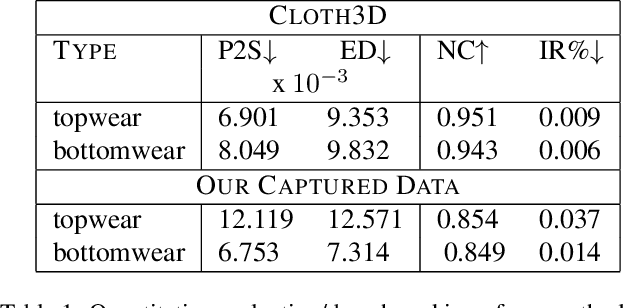
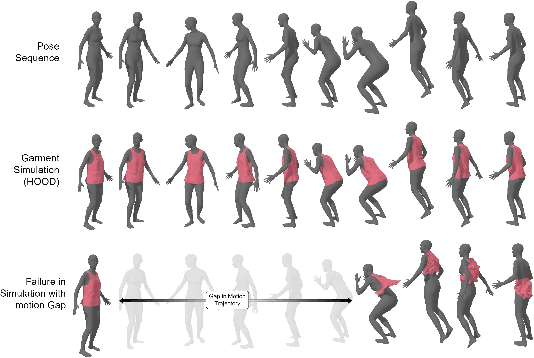
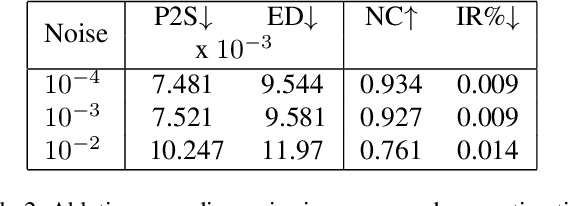
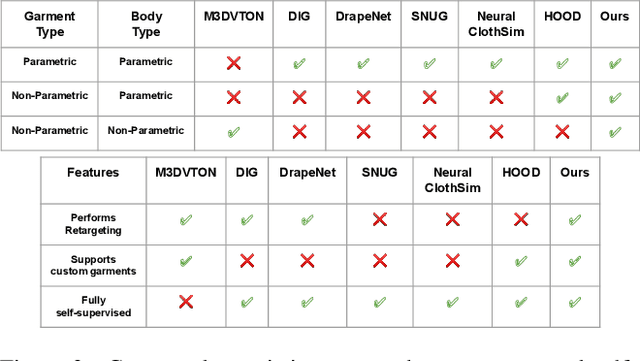
Abstract:We propose a novel self-supervised framework for retargeting non-parameterized 3D garments onto 3D human avatars of arbitrary shapes and poses, enabling 3D virtual try-on (VTON). Existing self-supervised 3D retargeting methods only support parametric and canonical garments, which can only be draped over parametric body, e.g. SMPL. To facilitate the non-parametric garments and body, we propose a novel method that introduces Isomap Embedding based correspondences matching between the garment and the human body to get a coarse alignment between the two meshes. We perform neural refinement of the coarse alignment in a self-supervised setting. Further, we leverage a Laplacian detail integration method for preserving the inherent details of the input garment. For evaluating our 3D non-parametric garment retargeting framework, we propose a dataset of 255 real-world garments with realistic noise and topological deformations. The dataset contains $44$ unique garments worn by 15 different subjects in 5 distinctive poses, captured using a multi-view RGBD capture setup. We show superior retargeting quality on non-parametric garments and human avatars over existing state-of-the-art methods, acting as the first-ever baseline on the proposed dataset for non-parametric 3D garment retargeting.
MANUS: Markerless Hand-Object Grasp Capture using Articulated 3D Gaussians
Dec 04, 2023



Abstract:Understanding how we grasp objects with our hands has important applications in areas like robotics and mixed reality. However, this challenging problem requires accurate modeling of the contact between hands and objects. To capture grasps, existing methods use skeletons, meshes, or parametric models that can cause misalignments resulting in inaccurate contacts. We present MANUS, a method for Markerless Hand-Object Grasp Capture using Articulated 3D Gaussians. We build a novel articulated 3D Gaussians representation that extends 3D Gaussian splatting for high-fidelity representation of articulating hands. Since our representation uses Gaussian primitives, it enables us to efficiently and accurately estimate contacts between the hand and the object. For the most accurate results, our method requires tens of camera views that current datasets do not provide. We therefore build MANUS-Grasps, a new dataset that contains hand-object grasps viewed from 53 cameras across 30+ scenes, 3 subjects, and comprising over 7M frames. In addition to extensive qualitative results, we also show that our method outperforms others on a quantitative contact evaluation method that uses paint transfer from the object to the hand.
Enhanced Spatio-Temporal Context for Temporally Consistent Robust 3D Human Motion Recovery from Monocular Videos
Nov 20, 2023



Abstract:Recovering temporally consistent 3D human body pose, shape and motion from a monocular video is a challenging task due to (self-)occlusions, poor lighting conditions, complex articulated body poses, depth ambiguity, and limited availability of annotated data. Further, doing a simple perframe estimation is insufficient as it leads to jittery and implausible results. In this paper, we propose a novel method for temporally consistent motion estimation from a monocular video. Instead of using generic ResNet-like features, our method uses a body-aware feature representation and an independent per-frame pose and camera initialization over a temporal window followed by a novel spatio-temporal feature aggregation by using a combination of self-similarity and self-attention over the body-aware features and the perframe initialization. Together, they yield enhanced spatiotemporal context for every frame by considering remaining past and future frames. These features are used to predict the pose and shape parameters of the human body model, which are further refined using an LSTM. Experimental results on the publicly available benchmark data show that our method attains significantly lower acceleration error and outperforms the existing state-of-the-art methods over all key quantitative evaluation metrics, including complex scenarios like partial occlusion, complex poses and even relatively low illumination.
Facial De-occlusion Network for Virtual Telepresence Systems
Oct 23, 2022Abstract:To see what is not in the image is one of the broader missions of computer vision. Technology to inpaint images has made significant progress with the coming of deep learning. This paper proposes a method to tackle occlusion specific to human faces. Virtual presence is a promising direction in communication and recreation for the future. However, Virtual Reality (VR) headsets occlude a significant portion of the face, hindering the photo-realistic appearance of the face in the virtual world. State-of-the-art image inpainting methods for de-occluding the eye region does not give usable results. To this end, we propose a working solution that gives usable results to tackle this problem enabling the use of the real-time photo-realistic de-occluded face of the user in VR settings.
xCloth: Extracting Template-free Textured 3D Clothes from a Monocular Image
Aug 27, 2022

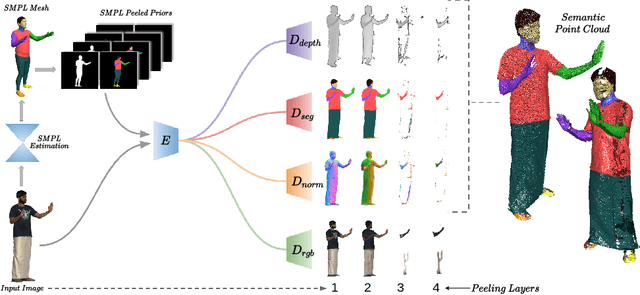

Abstract:Existing approaches for 3D garment reconstruction either assume a predefined template for the garment geometry (restricting them to fixed clothing styles) or yield vertex colored meshes (lacking high-frequency textural details). Our novel framework co-learns geometric and semantic information of garment surface from the input monocular image for template-free textured 3D garment digitization. More specifically, we propose to extend PeeledHuman representation to predict the pixel-aligned, layered depth and semantic maps to extract 3D garments. The layered representation is further exploited to UV parametrize the arbitrary surface of the extracted garment without any human intervention to form a UV atlas. The texture is then imparted on the UV atlas in a hybrid fashion by first projecting pixels from the input image to UV space for the visible region, followed by inpainting the occluded regions. Thus, we are able to digitize arbitrarily loose clothing styles while retaining high-frequency textural details from a monocular image. We achieve high-fidelity 3D garment reconstruction results on three publicly available datasets and generalization on internet images.
N2NSkip: Learning Highly Sparse Networks using Neuron-to-Neuron Skip Connections
Aug 07, 2022
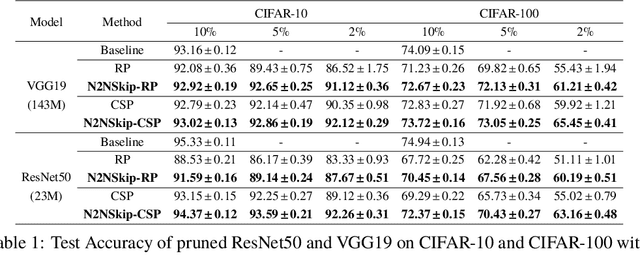


Abstract:The over-parametrized nature of Deep Neural Networks leads to considerable hindrances during deployment on low-end devices with time and space constraints. Network pruning strategies that sparsify DNNs using iterative prune-train schemes are often computationally expensive. As a result, techniques that prune at initialization, prior to training, have become increasingly popular. In this work, we propose neuron-to-neuron skip connections, which act as sparse weighted skip connections, to enhance the overall connectivity of pruned DNNs. Following a preliminary pruning step, N2NSkip connections are randomly added between individual neurons/channels of the pruned network, while maintaining the overall sparsity of the network. We demonstrate that introducing N2NSkip connections in pruned networks enables significantly superior performance, especially at high sparsity levels, as compared to pruned networks without N2NSkip connections. Additionally, we present a heat diffusion-based connectivity analysis to quantitatively determine the connectivity of the pruned network with respect to the reference network. We evaluate the efficacy of our approach on two different preliminary pruning methods which prune at initialization, and consistently obtain superior performance by exploiting the enhanced connectivity resulting from N2NSkip connections.
 Add to Chrome
Add to Chrome Add to Firefox
Add to Firefox Add to Edge
Add to Edge